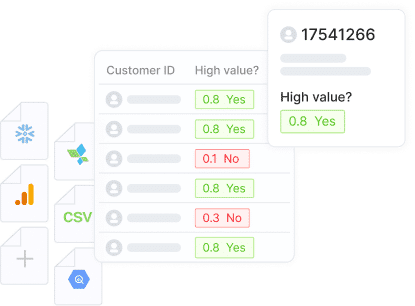In a nutshell:
- Augmented analytics tools are revolutionizing data analysis by automating processes and generating actionable insights.
- Selecting the right tool involves considering data integration, machine learning capabilities, and user interface.
- Implementing these tools requires integration with existing infrastructure, user training, and measuring impact on decision-making.
- Augmented analytics democratizes data analysis, enabling non-technical users to make data-driven decisions and fostering cross-functional collaboration.
- Best practices for data leaders include creating a roadmap, ensuring data governance, empowering data analysts, and promoting a culture of data literacy.
"Drowning in information but starving for insights": Does this scenario sound familiar? As the volume and complexity of data continue to grow exponentially, traditional analytics methods are struggling to keep pace. Enter augmented analytics – a game-changing approach that's revolutionizing how organizations extract value from their data.
Augmented analytics tools, powered by artificial intelligence and machine learning, are transforming the data analysis landscape. These innovative solutions automate data preparation, uncover hidden patterns, and generate actionable insights with unprecedented speed and accuracy.
By augmenting human intelligence with machine capabilities, these tools are democratizing data science, enabling business users to perform complex analyses that once required teams of specialized data scientists.
From evaluating key criteria for tool selection to best practices for adoption, this post will provide valuable insights for data leaders looking to drive their organization's success through data-driven decision-making.
Evaluating Augmented Analytics Tools
Choosing the right augmented analytics tool for your organization is what allows you to make good data-driven decisions. But with a plethora of options available in the market, how do you make the right choice?
While the best choice will always vary based on your specific needs, some key criteria that can guide you in evaluating the best tool include:
Data Integration and Compatibility
The first thing to consider is data integration and compatibility. A good augmented analytics tool can easily integrate with your existing data infrastructure and handle diverse data types and sources. This allows for a seamless data flow across different platforms and tools, providing a unified view of your organization's data.
Machine Learning and AI Capabilities
A tool must incorporate machine learning and AI capabilities to be classified as an augmented analytics tool. These capabilities can help to automate data preparation, pattern detection, and insight generation, reducing the time and complexity of data analysis. These capabilities must be robust and well-suited to your organization’s specific needs.
User Interface and Ease of Use
The primary aim of augmented analytics is to democratize data analytics. A difficult-to-use tool will fall short of this goal. Therefore, you should look for a tool with an intuitive user interface that doesn’t require advanced technical skills to operate. This will ensure that technical and non-technical team members can easily navigate the tool and derive meaningful insights from your data.
Implementing Augmented Analytics Tools
Implementing augmented analytics tools is about introducing a new tool into your existing data infrastructure and managing the change that comes with it. A well-planned and structured implementation can ensure smooth adoption and impact the decision-making processes. For the best chance at success, keep these ideas in mind as you work:
Integration With Existing Data Infrastructure
You should select an augmented analytics tool that can integrate seamlessly with your existing data infrastructure. This makes installation much easier and prevents timely and costly work to bring everything into a compatible state.
The tool you pick should already be able to work with your current data sources and formats, ensuring there is no disruption in your data processes while providing a unified, comprehensive view of all your data. It should also automate data preparation and management since this can speed up performance.
User Training and Change Management
User adoption is critical for the successful implementation of augmented analytics tools. Training should be provided to all users, regardless of their technical ability, to enhance their comfort and proficiency with the tool. This includes understanding the tool’s capabilities and knowing how to interpret the insights generated by it.
Change management also plays a significant role in successful implementation. Employees may resist the change initially for reasons ranging from not understanding how it works or simply being unwilling to change, so communicating the benefits and providing continuous support can help alleviate these concerns and facilitate a smooth transition.
Measuring the Impact on Decision-Making Processes
Once the tool is implemented, measure its impact on your decision-making processes. Look at how decisions are made, the time taken, and the quality of those decisions compared to those metrics from before the tool was integrated into your process. This analysis can provide valuable insight into the tool’s effectiveness and inform necessary adjustments as you continue to test and adjust.
Democratizing Data Analysis With Augmented Analytics
Traditionally, making sense of massive amounts of data required a highly specialized skill set that was absent in most parts of an organization. This meant that data-driven decision-making was often limited to a select few who had the technical capability to analyze and interpret the data.
Thankfully, augmented analytics have led to the democratization of data analysis, empowering even non-technical users to make data-driven decisions. Between this and the other ways users benefit from these kinds of tools, it’s no wonder they’re taking off in various industries.
Empowering Non-Technical Users With Self-Service Analytics
Data analysis was reserved for expert data analysts and scientists for the longest time. However, augmented analytics tools’ intuitive user interfaces and machine learning capabilities empower non-technical users with self-service analytics. Users can easily explore and interact with data, generating insights that are easy to understand and apply.
Enabling Cross-Functional Collaboration Through Data Democratization
This democratization also fosters an environment of shared understanding and transparency. When data is made accessible to everyone, it eliminates the information silos that often exist in large organizations. Augmented analytics promotes cross-functional collaboration by giving everyone in an organization access to analytics and insights.
Different teams, whether marketing, sales, HR, or customer service, can leverage the same data, ensuring alignment around the same truths and enabling better decision-making, creativity, and innovative solutions to problems.
Creating Value and Uncovering New Benefits From Data
The ability of augmented analytics to allow more individuals in an organization to interact with and interpret data can lead to a myriad of unforeseen benefits.
With more eyes on the data, fresh perspectives and interpretations could lead to identifying new opportunities and strategies. It can also streamline communication by creating a common data language shared across teams, eliminating the need for technical translation and improving efficiency.
The newfound ease of use can spawn curiosity among team members, inspiring them to delve deeper into the data and improve their data literacy skills. These help foster a culture of continuous learning and improvement among employees, making for a stronger, smarter, and more effective workplace.
How Pecan AI Enables Data Analysts to Use Machine Learning
Pecan AI is a game changer in the world of augmented analytics. Built with the vision to democratize machine learning, Pecan AI goes above and beyond to provide data analysts with a user-friendly interface that doesn’t compromise the complexity and depth of the data explored. It offers a no-code predictive analytics platform that allows data analysts to build predictive models using SQL.
Pecan AI simplifies the process of building ML models by automating data preparation, model building, and model evaluation, eliminating the guesswork often associated with model selection and tuning. This speeds up the process, increases the accuracy of the models built, and ensures consistency.
Best Practices for Data Leaders
There are some growing pains when implementing new technology within an organization. The data leaders are responsible for making this process as easy as possible for everyone, so following several best practices can help.
Anyone in a leadership position in the process of adding an augmented analytics tool to their organization should incorporate the following into their efforts:
Creating a Roadmap for Augmented Analytics Adoption
Craft a clear roadmap that outlines the steps needed to implement augmented analytics in your organization. This should include choosing the right tool, integration, user training, and measuring impact.
By being transparent and planning things well, you can more easily implement things in stages and assuage employees’ fears during the transition process.
Ensuring Data Governance and Security in Augmented Analytics
Data governance and security should be a priority in augmented analytics. Ensure that your data is properly managed and protected and that your chosen analytics tool complies with your organization’s data governance and security policies. New tools don’t mean all prior security knowledge should go out the window.
Use Staff Efficiently by Extending Augmented Analytics Capabilities to Data Analysts
Augmented analytics can empower data analysts, so leaders should utilize their existing skill sets. Allowing your data analysts to use augmented analytic tools can bolster their ability to generate insights and make data-driven recommendations.
These tools allow more autonomy, reduce dependency on data science teams, and enable them to contribute more effectively to strategic decision-making. They also enhance cross-functional collaboration, as data analysts often work closely with various departments, helping them make sense of their data and use it to drive success.
Focus Data Scientists' Efforts on More Complex Projects Requiring High Levels of Customization and Technical Sophistication
While augmented analytics simplifies many tasks, some problems require advanced technical skills. Data scientists should therefore focus their efforts on these more complex projects.
This is one area where augmented analytics tools help solve their problems. The automation they provide frees up data scientists to work on those more complex projects rather than waste their time handling simpler issues or easy tasks.
Promoting a Culture of Data Literacy
An important aspect of successfully implementing augmented analytics tools and democratizing data in your organization is promoting a culture of data literacy. This means ensuring all team members, technical and non-technical alike, understand the language of data. They should be comfortable interpreting data, asking critical questions, and making decisions based on data-driven insights.
Workshops, training sessions, and regular discussions around data can help foster this culture. A data-literate team will be able to leverage the full potential of augmented analytics tools, leading to improved decision-making and overall performance.
Encouraging Experimentation and Innovation
Data leaders should also encourage their teams to experiment with augmented analytics tools to find new ways to use them in the workplace. This can involve testing different features, exploring various datasets, and attempting to draw unique insights.
This experimentation often leads to its innovative uses and unexpected, valuable insights. It also helps users to become more proficient and comfortable with the tool, further promoting its adoption.
Setting Realistic Expectations and Goals
Augmented analytics tools can greatly enhance your data capabilities and set realistic expectations and goals. Implementing these tools is not an instant solution to all data challenges.
There will be a learning curve, and the full benefits might not be immediately apparent. Setting realistic, incremental goals can help manage expectations, track progress, and motivate teams.
Make the Most Out of Augmented Analytics Tools With Pecan AI
Augmented analytics tools provide countless benefits to organizations, democratizing data analytics and empowering data-driven decision-making at all levels. Organizations can revolutionize their decision-making processes through intelligent evaluation, implementation, and adoption of tools like Pecan AI.
Explore Pecan AI and get in touch to see how you can easily bring the power of predictive analytics to your team.










